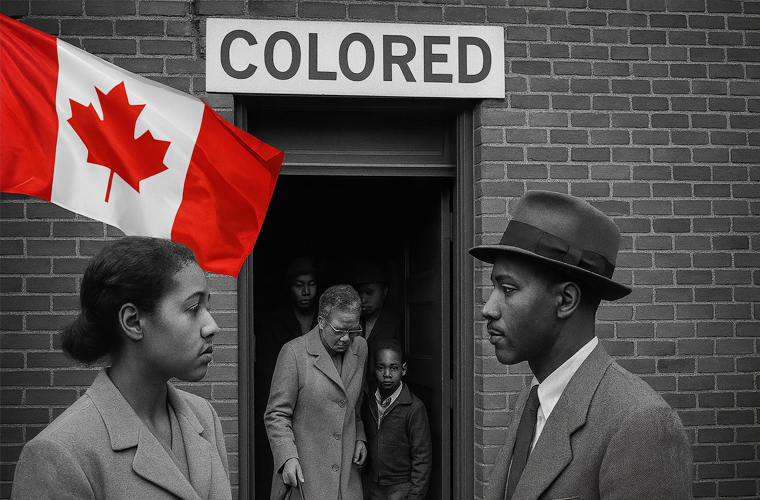A Historical and Contemporary Perspective
Segregation in Canada, while often overshadowed by the more overt Jim Crow laws of the United States, was a pervasive system that systematically separated racialized groups—particularly Black, Indigenous, and Asian communities—from white society. Enforced through legislation, court rulings, and social customs, it permeated education, housing, employment, healthcare, and public spaces, leaving a lasting legacy of inequality that persists to this day. Unlike the U.S., Canadian segregation applied broadly to all non-whites and was intertwined with restrictive immigration policies that limited entry until the 1960s. This article explores its historical roots, key events, resistance efforts, and ongoing challenges as of 2025.
Canada’s history of segregation traces back to colonial times, rooted in slavery, colonialism, and notions of racial superiority. Formal practices ended in the mid-20th century, but informal barriers lingered.
Black presence in Canada dates to the 1600s, with enslaved Africans brought by French and British colonizers. Slavery was abolished in 1834, but segregation followed, confining Black people to inferior schools, jobs, and facilities. In Ontario and Nova Scotia, the 1850 Common Schools Act allowed separate schools for racial and religious groups, leading to underfunded Black-only institutions that operated until 1965 in Ontario and 1983 in Nova Scotia. Black students often attended in shifts or dilapidated buildings, perpetuating educational disparities.
Housing covenants restricted Black homeownership; for instance, in Calgary during the 1920s, Black families were limited to areas near railway yards, while Vancouver deeds from 1928 to 1965 barred sales to “any person of the Chinese, Japanese, or other Asiatic race or to any Indian or Negro.” Employment was similarly stratified: Black workers were funneled into low-wage roles like porters and domestics, excluded from unions and promotions.
Indigenous segregation was embedded in colonial policies aimed at assimilation. The Indian Act of 1876 confined First Nations, Métis, and Inuit to reserves, restricting movement and rights. The residential school system, operating from the 1880s to 1996, forcibly removed over 150,000 children from their families to erase Indigenous cultures. Funded by the government and run by churches, these schools prohibited native languages and traditions, leading to abuse, neglect, and thousands of deaths—recent discoveries of unmarked graves underscore this “cultural genocide.”
Healthcare was segregated, too: “Indian hospitals” provided substandard care, with non-consensual medical experiments on Indigenous patients. Blood donations were racially segregated until the 1960s, deeming Indigenous and Black blood “inferior.”
Asian immigrants, primarily Chinese and Japanese, faced exclusionary laws. The 1885 Chinese Immigration Act imposed a head tax, escalating to $500 by 1903 and collecting $23 million from 81,000 people. The 1923 Chinese Immigration Act halted immigration almost entirely until 1947. In British Columbia, Chinese students were segregated into separate schools in 1922 to limit English exposure, and Japanese education was disrupted during World War II internment. Restrictive covenants and employment bans, like prohibiting Chinese owners from hiring white women in Saskatchewan, further isolated communities.
Iconic cases galvanized change. In 1946, Viola Desmond was arrested in New Glasgow, Nova Scotia, for sitting in the whites-only section of a theater, fined for a minor tax violation instead of the real offense. Her case, though she lost in court, inspired anti-segregation activism. Similarly, Fred Christie’s 1939 Supreme Court loss after a Montreal tavern refused him service affirmed businesses’ right to discriminate.
Resistance was fierce: Black communities boycotted segregated schools, formed organizations like the Nova Scotia Association for the Advancement of Coloured People, and pursued lawsuits. Indigenous survivors testified at the Truth and Reconciliation Commission (2008–2015), leading to 94 Calls to Action.
Asian Canadians challenged head taxes through petitions, culminating in a 1988 government apology and redress. These efforts pressured reforms: Ontario’s 1944 Racial Discrimination Act banned discriminatory signs, followed by fair employment and accommodation laws in the 1950s.
The 1960 Canadian Bill of Rights and 1982 Charter of Rights and Freedoms enshrined equality, outlawing discrimination. The last segregated school closed in 1983, and immigration shifted to a points-based system in 1967, ending racial quotas. Yet, enforcement relied on provincial human rights codes, leaving gaps.
As of 2025, formal segregation is gone, but systemic racism endures. Nearly half (46%) of Black Canadians reported discrimination in the past five years, with Black people most likely to face racism overall. Racialized groups, including 45% of those aged 15+, experienced racism in 2024. Indigenous communities grapple with overrepresentation in child welfare and prisons, tied to residential school legacies.
Government responses include the 2024–2028 Anti-Racism Strategy, which focuses on equity, and the Black Justice Strategy, launched in 2025. A Leger poll in October 2025 found nearly half of Canadians witnessed systemic racism provincially. Efforts like restorative engagement in the Canadian Armed Forces address military discrimination.

